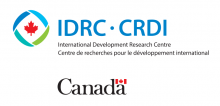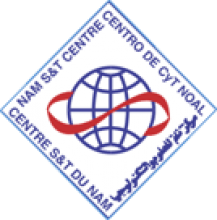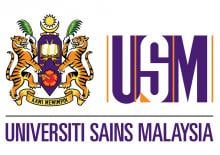Science
News

18 Jun 2007
Political, economic, and social change can allow research to inform change. IDRC shares its experience in eight countries - Algeria, Burma, Cambodia, Kenya, South Africa, the Southern Cone, Vietnam, and the West Bank and Gaza.

18 Jun 2007
The recommendations from the International Roundtable on Lightning Protection include designing protective devices suitable to local conditions, more research in high frequency earthing systems and protection technologies, country wide networked lighting detection system and an International Institute for Lighting Protection and Safety.

17 Jun 2007
New neurodegenerative mouse mutant, Optimizing calcium detection, International survey of human embryonic stem cell lines, Genetic engineering boosts biofuel yield from alfalfa, Genome sequences of Leishmania parasites, Empathy: A touching experience, Dialling down ‘natural’ antibody production, Fish tumours visualized by ultrasound

15 Jun 2007
Two genes have been identified that are essential to the reproduction of the hepatitis B virus and are therefore potential targets for novel anti-HBV drugs, A flowering-plant fossil tells us about the origin of the first flowers on Earth, Catalytic carbon nanotube reactors boost ethanol production and more

13 Jun 2007
Summaries of newsworthy papers include Saturn’s magnetosphere gets the Cassini treatment, Transients in the sky: Stellar puzzle, Why cold is such a pain, Human carbon footprint leaves a lasting mark on forests, Water on Mars revisited and The eyes have it

13 Jun 2007
The remains of a gigantic, surprisingly bird-like dinosaur have been uncovered in Inner Mongolia, China.

10 Jun 2007
Genetic variants predisposing to celiac disease, Regulating insensitivity to DNA damage, Getting specific with miRNA production, Following mitochondria in mouse neurons and Recombinant RNA

08 Jun 2007
Sarawak, Malaysia - Unimas (University Malaysia Sarawak) will collaborate with European and South-East Asian Partners to develop the Computerized Automative Technology Reconfiguration System for Mass Customization (CATER).

08 Jun 2007
Serdang, Malaysia - Australia's University of Newcastle and UPM explore cooperation avenues.

08 Jun 2007
Serdang, Malaysia - The main aim of the MOU includes promoting staff exchange programme, industry training for students, research collaboration, external examiner exchange and others.

08 Jun 2007
An exciting new program just launched in Asia is encouraging some of the world’s best and brightest young scientists to consider careers helping developing nations, instead of taking jobs focused on the developed world.

06 Jun 2007
Potential drug for atherosclerosis and type 2 diabetes, DNA damage contributes to stem cell ageing, MicroRNAs and tumour suppression, Hurricanes: Back to normal?, Evolution: It’s all so predictable and finally Fishy genome swims into view

06 Jun 2007
Penang, Malaysia - Muslim countries have been urged to increase cooperation and research links, particularly in improving the management quality of hajj.

06 Jun 2007
A University of Queensland scientist at the Queensland Brain Institute has uncovered evidence that could help to explain why some stroke patients have trouble maintaining a stable image of their visual world when they make eye movements.

05 Jun 2007
Sarawak, Malaysia - UNIMAS and University of South Florida (UNIMAS-USF) education and research partnership was forged through a Memorandum of Understanding.

05 Jun 2007
Sarawak, Malaysia - One of the most important output of ICREPE activities to date has been published “Wise Use of Tropical Peatlands: Focus on Southeast Asia”.

03 Jun 2007
Summaries of newsworthy papers include Quantum communication over 144 km in Nature Physics and In praise of forgetting in Nature Neuroscience

01 Jun 2007
Studies can be on managerial, epidemiological or behavioral issues with respect to communicable diseases, including HIV/AIDS, but excluding clinical interventions. The deadline for submission of Expression of Interest is 28 June 2007

01 Jun 2007
Asia Pacific Conference on Plant Tissue Culture and Agribiotechnology (APaCPA) 2007 - "Biotechnology for Better Food, Health and Quality Living" 17 - 21 June 2007, PWTC, Kuala Lumpur, Malaysia

31 May 2007
Indian Government and Keio University co-hosted the international workshop “Light Path to India” in Delhi last week to promote collaboration in advanced research projects among Asian countries utilizing the latest Information Technology

30 May 2007
The winning inventions include Violet Biothread, Dairy Probiotic, Biofiltration for Wastewater Treatment, Industrial Sludge Reduction Using Biomass Extract, Corporate Governance Screencard, Malaysian Café, Biodegradable Natural Colour Pencils, Drug Delivery System for Herbal Extracts and Semi-Purification Process of Bioactive Herbal Fractions

30 May 2007
Summaries of newsworthy papers include Chilly receptor, Very short RNAs make unexpected appearance, Tropical cyclones mix things up, Neuronal duo implicated in diet-restricted ageing, Water vapour in planetary birthplace, Arithmetic is child’s play, Putting a spin on logic gates and How animal ‘personalities’ came to be

27 May 2007
Summaries of newsworthy papers include : DNA breakage in living colour – Nature Genetics, Forever blowing bubbles – Nature Nanotechnology and Checking immune activation – Nature Immunology

25 May 2007
UiTM also received four international awards namely; the ARCA Award (Croatia), British Inventors Society Award (BIS) and INPEX Award (USA). The GENEVA Award (Switzerland) was also won by UiTM for receiving the highest gold medals.

24 May 2007
Innovating Towards Sustainability - The best innovative ideas will be awarded grants in collaboration with Malaysian researchers. The abstracts should be submitted by 15 June 2007.

24 May 2007
Prof. Shigeru Watanabe and Associate Prof. Eiichi Izawa of Keio University and his group became the first in the world to succeed in drawing up a stereotaxic atlas of a crow. Crows are known to be smart, and the findings proved that the pallium of the crow brain, which is related to intellectual activities, is well developed.

24 May 2007
A baby girl of extremely low birthweight, born in Keio University Hospital on 25 October, 2006, was discharged from the hospital on 3 April in good health. Born weighing only 265 grams, she is the smallest baby ever survived in Japan, and the second smallest throughout the world.

23 May 2007
Summaries of newsworthy papers include Biophysics: Clustering key to membrane remodelling, Optical materials: Semiconducting nanocrystals light up the way, Evolution: Paddlefish clues to limb development

22 May 2007
Serious infestation of weedy rice or locally known as "padi angin" had been reported to reduce rice yield up to 75%. UPM researchers have developed a novel seed treatment to counter the infestation
Giants in history
Chinese biochemist Chi Che Wang (1894 - 1979), one of the first Chinese women to study abroad, advanced to prominent research positions at American institutions including the University of Chicago and the Northwestern University Medical School.
Ruby Sakae Hirose (1904 – 1960) was a Japanese-American scientist whose research contributed significantly to our understanding of blood clotting, allergies and cancer.
Chinese electron microscopy specialist Li Fanghua (6 January 1932 – 24 January 2020) facilitated the high-resolution imaging of crystal structures by eliminating interference.
Sálim Moizuddin Abdul Ali (12 November 1896 – 20 June 1987), commonly referred to as the Birdman of India, was the first person to conduct systematic surveys of birds from across India.
Haisako Koyama (1916 – 1997) was a Japanese solar observer whose dedication to recording sunspots – cooler parts of the sun’s surface that appear dark – produced a sunspot record of historic importance.
Michiaki Takahashi (17 February 1928 – 16 December 2013) was a Japanese virologist who developed the first chickenpox vaccine.
Toshiko Yuasa (11 December 1909 – 1 February 1980) was the first Japanese female physicist whose research on radioactivity shed light on beta decay – the process in which an atom emits a beta particle (electron) and turns into a different element.
Angelita Castro Kelly (1942-2015) was the first female Mission Operations Manager (MOM) of NASA. She spearheaded and supervised the Earth Observing System missions during its developmental stage.
Malaysia’s first astrophysicist, Mazlan binti Othman (born 11 December 1951) was instrumental in launching the country’s first microsatellite, and in sending Malaysia’s first astronaut, Sheikh Muszaphar Shukor, into space.
Known as Mr. Natural Rubber, chemist and researcher B. C. Shekhar (17 November 1929 – 6 September 2006) introduced a number of technical innovations that helped put Malaysia’s natural rubber industry on the world map.
Shinichiro Tomonaga (31 March 1906 – 8 July 1979), together with Richard Feynman and Julian Schwinger, was awarded the Nobel Prize in Physics in 1965, for their contributions to advance the field of quantum electrodynamics. Tomonaga was also a strong proponent of peace, who actively campaigned against the proliferation of nuclear weapons and promoted the peaceful use of nuclear energy.
South Korean theoretical physicist Daniel Chonghan Hong (3 March 1956 – 6 July 2002) achieved fame in the public sphere through his research into the physics of popcorn.
Japanese chemist Kenichi Fukui (4 October 1918 – 9 January 1998) was the first Asian scientist to be awarded the Nobel Prize in Chemistry. Together with Roald Hoffman, he received this honour in 1981 for his independent research into the mechanisms of chemical reactions.
Chinese palaeontologist, archaeologist and anthropologist Pei Wenzhong (January 19, 1904 – September 18, 1982) is regarded as a founder of Chinese anthropology.
Physicist Narinder Singh Kapany (31 October 1926 – 4 December 2020) pioneered the use of optical fibres to transmit images, and founded several optical technology companies. Born in Punjab, India, he worked at a local optical instruments factory before moving to London for PhD studies at Imperial College. There, he devised a flexible fibrescope to convey images along bundles of glass fibres.
Japanese physicist Ukichiro Nakaya (1900-1962) made the world’s first artificial snowflakes. He started his research on snow crystals in the early 1930s at Hokkaido University, where there is an unlimited supply of natural snow in winter. By taking over 3,000 photographs, he established a classification of natural snow crystals and described their relationship with weather conditions.
The field of solid-state ionics originated in Europe, but Takehiko Takahashi of Nagoya University in Japan was the first to coin the term ‘solid ionics’ in 1967. ‘Solid-state ionics’ first appeared in 1971 in another of his papers, and was likely a play on ‘solid-state electronics’, another rapidly growing field at the time.
Charles Kuen Kao (Nov. 4, 1933 to Sept. 23, 2018) was an engineer who is regarded as the father of fibre optics. His work in the 1960s on long distance signal transmission using very pure glass fibres revolutionized telecommunications, enabling innovations such as the Internet.
Chika Kuroda (24 March 1884 – 8 November 1968) was a Japanese chemist whose research focussed on the structures of natural pigments.
Motoo Kimura (13 November 1924 – 13 November 1994) was a Japanese theoretical population geneticist who is best remembered for developing the neutral theory of molecular evolution.
Meghnad Saha (6 October 1893 – 16 February 1956) was an Indian astrophysicist best known for formulating the Saha ionization equation which describes the chemical and physical properties of stars.
Sir Jagadish Chandra Bose (30 November 1858 – 23 November 1937) was a scientist and inventor who contributed to a wide range of scientific fields such as physics, botany and biology.
Osamu Shimomura (27 August 1928 – 19 October 2018) was a Japanese organic chemist and marine biologist who dedicated his career to understanding how organisms emitted light.
Subrahmanyan Chandrasekhar (19 October 1910 – 21 August 1995) was an Indian astrophysicist who studied the structure and evolution of stars.
Joo-myung Seok (November 13, 1908 – October 6, 1950) was a Korean butterfly entomologist who made important contributions to the taxonomy of the native butterfly species in Korea.
Mathematician Maryam Mirzakhani (12 May 1977 – 14 July 2017) was the first and only woman and Iranian to date to win the Fields Medal in 2014 for her work on curved surfaces.
Sir Chandrasekhara Venkata Raman (7 November 1888 – 21 November 1970) was an Indian physicist who performed ground-breaking research in the field of light-scattering.
Mohammad Abdus Salam (29 January 1926 – 21 November 1996) was a theoretical physicist and the first Pakistani to receive a Nobel Prize in science.
Srinivasa Ramanujan (22 December 1887 – 26 April 1920) was a math prodigy and widely considered one of India’s greatest mathematicians. Despite having almost no formal training in mathematics, he made substantial contributions to mathematical analysis, number theory, infinite series and continued fractions.
Gopalasamudram Narayanan Ramachandran (8 October 1922 – 7 April 2001) is best known for developing the Ramachandran plot to understand the structure of short chains of amino acids, known as peptides.
Hitoshi Kihara (1893 – 1986) was one of the most famous Japanese geneticists of the 20th century. One of his most significant contributions was identifying sex chromosomes (X and Y) in flowering plants.
Chien-Shiung Wu (31 May 1912 – 16 February 1997) was an experimental physicist who made several important contributions to nuclear physics. Wu worked on the Manhattan Project – a top-secret program for the production of nuclear weapons during World War II and helped to develop a process for separating uranium into U235 and U238.
Meemann Chang (born 17 April 1936) is a Chinese palaeontologist who studied the fossils of ancient fish to understand the evolution of life. By examining fossils, she uncovered new insights on how vertebrates, animals with a backbone, migrated from the sea and became adapted to live on land.
Bibha Chowdhuri (1913 – 2 June 1991) was an Indian physicist who researched on particle physics and cosmic rays. In 1936, she was the only female to complete a M.Sc. degree at the University of Calcutta.
Lin Lanying (7 February 1918 – 4 March 2003) was a Chinese material engineer remembered for her contributions to the field of semiconductor and aerospace materials. Lanying was born into a family who did not believe in educating girls and she was not allowed to go to school.
Japanese geochemist Katsuko Saruhashi developed the first method and tools for measuring carbon dioxide in seawater





































